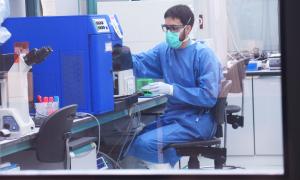The Beta variant goes beyond humans and also infects mice, unlike the original SARS-CoV-2

A new study by the CBIG consortium, formed by IrsiCaixa, the Barcelona Supercomputing Center and the IRTA, shows that the high transmission capacity of the Beta variant allows it to also infect mice, a fact that does not occur with the original virus. Until now, mice could only be infected if they had genetic modifications
SARS-CoV-2 is a virus of animal origin that made the leap to humans, causing the current COVID-19 pandemic. Although the virus has been generating new variants that have been maintained mainly among the human population, researchers at the IrsiCaixa AIDS Research Institute –a center promoted jointly by the "la Caixa" Foundation and the Department of Health of the Generalitat de Catalunya–, together with the Barcelona Supercomputing Center and the Animal Health Research Center (CReSA) of the Institute of Agrifood Research and Technology (IRTA), within the framework of the CBIG consortium, have described that the Beta variant (detected for the first time in South Africa), due to its high infectivity, it can also infect mice. This study has been possible thanks to the biosafety facilities of the Center for Comparative Medicine and Bioimaging (CMCiB) that the Germans Trias i Pujol Institute (IGTP) has at the Can Ruti Campus. The study shows that, while the first variant described in Europe exclusively infects transgenic mice –that is, they simulate the process of infection of SARS-CoV-2 in humans–, the Beta variant can also infect common laboratory mice. This fact would allow the scientific community to use an experimental model with natural susceptibility to the virus. Furthermore, the ability of new virus variants to infect other animal species that were not susceptible to the original SARS-CoV-2 highlights the need for continuous and global surveillance of viral variability, focusing on one health, that is, in the interdependence of human and animal health.
Increased affinity of the virus for cell receptors
The research team was studying infection by different variants of SARS-CoV-2 in animal models when they found that the Beta variant was capable of infecting common laboratory mice. "The results led us to discover that this was due to the high affinity between the spike protein of this variant and ACE2 in mice, which is the cellular receptor through which SARS-CoV -2 can infect cells", justifies Julià Blanco, IGTP researcher at IrsiCaixa.
Computer models developed by the Barcelona Supercomputing Center (BSC) have provided an interpretation at the molecular level of why this affinity occurs. "The key lies in a set of mutations in the spike protein of the virus, which make this interaction possible", explains Miguel Romero, a BSC researcher.
"Normally, we would expect that the new SARS-CoV-2 variants would have more affinity for human ACE2 and, therefore, that it could only infect mice genetically modified to express this protein. However, mutations in the Beta variant allow it to bind it to the ACE2 of the mouse and, therefore, it can infect mice", adds Ferran Tarrés, IrsiCaixa predoctoral researcher and first author of the study.
The disease that this variant generates in mice is mild, that is, it does not generate severe symptoms since the mice's own immune systems can resolve it without complications. These data contrast with the disease caused by SARS-CoV-2 in transgenic mice, in which the infection is very severe and ends up inducing their death.
Human and animal health, hand in hand
The current variants of SARS-CoV-2 have certain characteristics –greater transmissibility and the ability to evade the immune response– that make them vulnerable to increasing their range of host organisms. That is, as new variants are generated, the probability that these also infect other non-human organisms increases, as in the case of the Beta variant.
The fact that mice become hosts of SARS-CoV-2 worries the scientific community and makes evident the importance of doing research from a global perspective, including the environmental, animal and human point of view (One Health). "As we already verified at the beginning of the pandemic, viruses can infect different types of living beings and, as new variants emerge, they can expand their capacity to infect new species", explains Joaquim Segalés, researcher at IRTA-CReSA. Specifically, the bibliography allows us to understand that viruses of the coronavirus family have a special facility to change hosts, being SARS-CoV-1, SARS-CoV-2 and MERS-CoV some of the examples. "Well, it is important not to reduce the monitoring of SARS-CoV-2 to humans. If we want to efficiently control the pandemic and prevent others that may come, we must dedicate efforts to studying how the virus also circulates in animals, and we will only achieve this by carrying out collaborative and interdisciplinary research", concludes Blanco.
Although the experiments confirming this finding have been carried out in the laboratory, the next step would be to demonstrate that, in a natural environment, the Beta variant is also capable of infecting mice, as has been shown in other species (mink, deer). However, the current study confirms the need to monitor the pandemic from a global perspective.